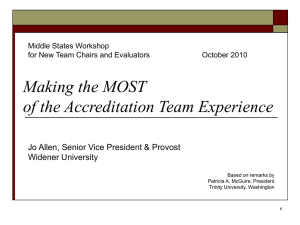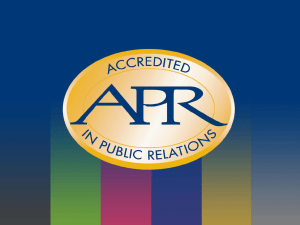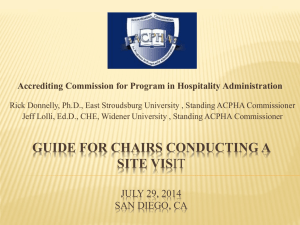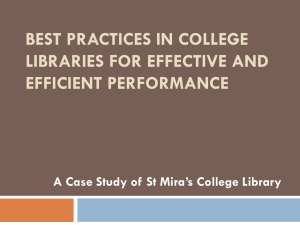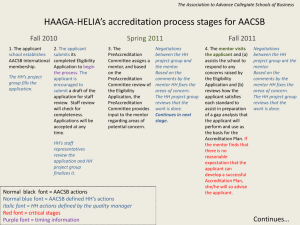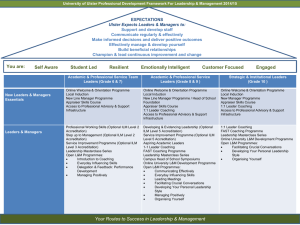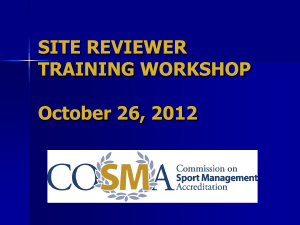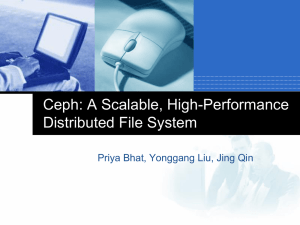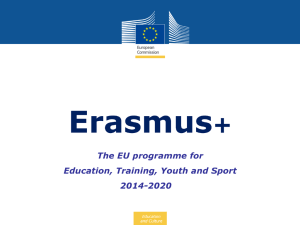full-time faculty member - Council on Education for Public Health
advertisement
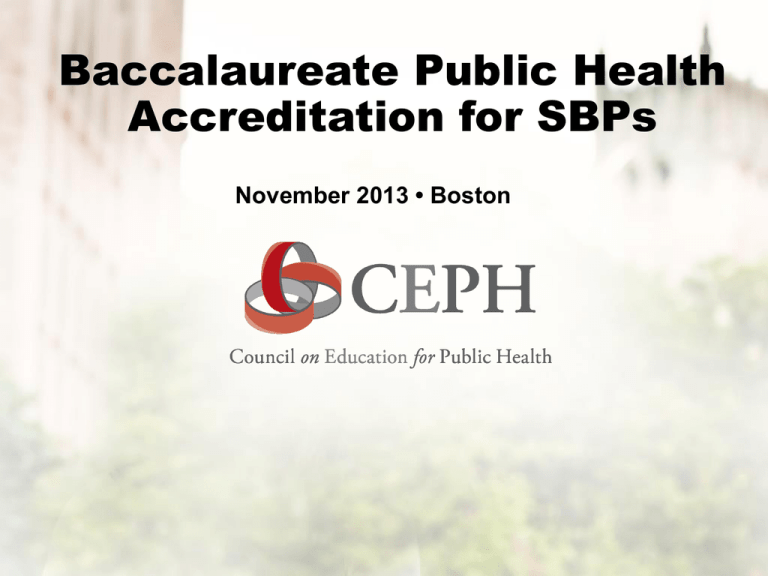
Baccalaureate Public Health Accreditation for SBPs November 2013 • Boston Council on Education for Public Health (CEPH) • An independent 501 (c) 3 agency • Recognized accreditor by the US Department of Education • Headquartered in Silver Spring, Maryland • Founded in 1974 by APHA and ASPPH • Services: Accreditation reviews, consultation, training, technical assistance, representing public health in higher education dialogue • We are responsive to and balance the needs of academia and practice. CEPH Objectives • to promote quality in public health education through a continuing process of self-evaluation by the schools and programs that seek accreditation; • to assure the public that institutions offering instruction in public health have been evaluated and judged to meet standards essential for the conduct of such educational programs; and • to encourage - through periodic review, consultation, research, publications, and other means - improvements in the quality of education for public health. Broad mission of public health defined by CEPH in 1978: “enhancing human health in populations, through organized community effort.” CEPH: Volunteers and Staff • Board of Councilors • 10 members (3 school reps, 3 practitioners, 2 program reps, 2 public members) • Meet 3 times per year • Staff • 7 full-time (Executive Director, Deputy Director, Communications Director, Accreditation Specialists/Coordinator, Office Manager) • Volunteers • Just under 200 academic and practitioner CEPH: Vital Statistics • Accredit 51 Schools of Public Health • Accredit 102 Public Health Programs • Accredit 153 total units • 30 schools and programs currently applicants • 20 schools and 8 programs include at least one UG PH degree in unit of accreditation • Accredit in 45 states plus DC & PR • Accredit in 4 countries outside US (Canada, Mexico, Lebanon, Grenada) • Public health is growing – adding about 5-10 new schools/programs annually The Road to Baccalaureate Accreditation 2003 2005 2007 • SOPHE/AAHE Accreditation Task Force Request • Council agreed to address this in evolving criteria revision • Criteria revision allowing PHP to include UG in accreditation unit • Developed TA paper on including UG in self-study • Developing system of UGCHE accreditation goal in 2007-2012 Strategic Plan • USDE included UG PHP in CEPH scope of recognition The Road to Baccalaureate Accreditation • Another request by SOPHE/AAHE Accreditation Task Force 2008 2009 • Questions arose about getting ahead of the field • CEPH solicited organizational comments on concept – content, process, value/importance, feasibility and unintended consequences The Road to Baccalaureate Accreditation 2010 2011 • Council considered organizational comments and decided to move forward with further exploration. • Thought Leaders met to discuss quality assurance in baccalaureate public health • Council adopted revised criteria for SPH and PHP to include baccalaureate degrees • Council formed three workgroups to advise on substantive issues related to future criteria for SBP Road to Baccalaureate Accreditation 2012 • CEPH participated in the development of the critical component elements • Council drafts accreditation criteria for standalone baccalaureate programs in public health 2013 • Council released proposed criteria for public comment and reviewed the comments • Council incorporated comments and adopted the accreditation criteria for SBP • Council amended the Accreditation Procedures to include SBP • CEPH released the SBP application template and is now accepting applications Procedures SBP Additions CEPH: Procedures 1. 2. 3. 4. 5. 6. 7. 8. 9. 10. Make contact with staff Submit complete application Attend Accreditation Orientation Workshop Begin self-study process (up to 2 years) Schedule site visit Consultation visit Submit preliminary self-study 5 months before visit – receive reader comments – make revisions Final self-study to team 30 days prior to visit Site visit – receive final report – written response Decision at next Council meeting **Process can take 2 ½ to 3 years Unit of Accreditation All SBP include only baccalaureate public health degree programs. Majors and degree programs that may be eligible for inclusion in an SBP include the following: • bachelor of public health (BPH) • bachelor of arts or bachelor of science in public health (BAPH, BSPH) • bachelor of arts (BA or AB) or bachelor of science (BS or SB) with a major in public health • bachelor of arts (BA or AB) or bachelor of science (BS or SB) with a major in a discipline of public health, such as epidemiology or health promotion • bachelor of arts (BA or AB) or bachelor of science (BS or SB) with a major in a closely related field, such as global health, international health, or health sciences/studies The following will not be eligible for inclusion in an SBP: • minors in public health, related fields or disciplines • certificates in public health • associate degrees in public health Unit of Accreditation • Variations in the organizational structure of SBP across institutions • Work with CEPH to establish the scope of accreditation • A regionally-accredited institution may contain a single accreditation unit, or a single institution may contain multiple CEPH accreditation units. • Each unit of accreditation is responsible for following CEPH’s procedures and criteria, and each accreditation unit will have its own accreditation status. In all cases, accredited units must be clear about which specific degree programs are included in the scope of accreditation. SBP Accreditation Reviews • Self-study • 100 pages • Site Visit • Purpose: to validate the self-study document with on-site interviews, review of materials • Length • 2 days Site Visitors • Will hold or recently held an academic position AND • Have a master’s degree in a public health discipline, at a minimum. OR • Will hold or recently held a position as a public health practitioner AND • Are or were primarily employed by a public health department, non-profit organization, healthcare organization, etc. AND • Possess at least 5 years of public health professional experience AND • Have a bachelor’s degree in a public health discipline, at a minimum. • All site visitors have strong writing, communication and analytical skills. • Will begin recruiting in Spring 204 Site Visit Teams Site visit teams for standalone baccalaureate programs include three members: • A chair, who has significant experience with CEPH site visits. This member may be a public health academic or practitioner. • A site visit coordinator, drawn from the full-time staff of CEPH, specifically trained consultant with significant experience in accreditation, or from a cadre of experienced CEPH site visitors specially trained to assume the role. • One additional member, who may be a public health academic or practitioner, depending on the designation of the chair. CEPH Accreditation Support Schedule • Annual Application Fee: $2500 • Includes two attendees to the AOW • Accreditation Review Fee: $2700 • Payable only in year of site visit • Annual Support Fee: $3175 • Programs sponsored by more than one university: $4750 • On-site Consultation Visit: $1500 per day • Other costs and charges including actual travel and living expenses for all individuals involved in consultation and evaluation visits. http://ceph.org/assets/Fee_Schedule2014.pdf Applicant Phase 2-year process During the Applicant Phase • Write your self-study • Must be submitted within two years of application acceptance • Attend the Accreditation Orientation Workshop (AOW) • Host an on-site consultation visit • Regularly communicate with and ask questions of CEPH staff • CEPH staff is there to guide you through the process! Accreditation timeline (example) Submit application Application accepted (May 2014) (June 2014) Contact CEPH to schedule consult visit Have consult visit (July - Oct 2015) (Oct 2015-March 2016) Attend Accreditation Orientation Workshop Contact CEPH to schedule site visit (late July/early Aug 2014) (January 2015) Submit preliminary self-study document Receive reviewers’ comments on preliminary self-study (June 2016) Incorporate comments Submit final self-study Have site visit (Sep-Nov 2016) (November 2016) (December 2016) Prepare response to draft report CEPH staff sends updated/corrected report to Council Council makes accreditation decision (March - May 2017) (May 2017) (June 2017) (August 2016) Receive draft site visit report (February 2017) Potential SBP Accreditation Timelines • Application: Winter 2014 • Preliminary self-study: Spring 2015 • Site Visit: Fall 2015 Fastest Track • Decision: Spring 2016 Fast Track • Application: Spring 2014 • Preliminary self-study: Fall 2015 • Site Visit: Spring 2016 • Decision: Fall 2016 Typical • Application: Fall 2014 • Preliminary self-study: Fall 2016 • Site Visit: Spring 2017 • Decision: Fall 2017 *Exact dates will be unique to each program. Upcoming Application Deadlines • Mid-February 2014 Application Decision • January 7, 2014 • Mid-June 2014 Application Decision • April 28, 2014 • Mid-September 2014 Application Decision • August 4, 2014 • Twice per year (Spring and Fall) thereafter Application Template Walkthrough Initiating the Review Process • Written application, addressed to the CEPH president, which summarizes its ability to meet the accreditation criteria • 15 pages or less, plus appendices if needed • Application template available at www.ceph.org • Address each item individually and succinctly Application Components 1. A statement indicating that the program understands the required components of the accreditation process (AOW, Consult Visits, etc.) 2. A request signed by the chief executive officer of the institution and cosigned the chief administrative officer of the university unit in which the program is located and by the program’s designated leader. 3. Documentation of the eligibility requirements found in the Accreditation Procedures. Eligibility Requirements 3a. Statement of Regional Accreditation Documentation of location in an institution that is regionally accredited (an applicant institution located outside the United States that is not eligible for regional accreditation must demonstrate a comparable external evaluation process). Eligibility Requirements 3.b Organizational Structure Establishment, or planned implementation (with timeline), of an organizational structure for the program with documented primary responsibility for curriculum development, admission standards, faculty selection and retention, and fiscal planning; documentation should include an organizational chart or charts that shows the program’s internal organization and external reporting lines up to and including the president, provost or other chief executive, as well as a narrative explanation of the roles and responsibilities mentioned above. Eligibility Requirements 3c. Mission and Expected Student Learning Outcomes A mission and expected student learning objectives for the program that aligns with the mission statement(s) of the parent institution(s) and the institution(s) regional accreditation standards. Eligibility Requirements 3d. Curriculum Overview A curriculum for each degree included in the unit of accreditation that is consonant with CEPH criteria; documentation must include a description of general education requirements, list of required courses, cumulative experiential activities, etc. and associated credit-hours, with brief course descriptions. Eligibility Requirements 3e. Institutional Commitment and Fiscal Support Evidence of institutional commitment and fiscal support for the development and/or maintenance of the program; documentation may include evidence of commitments for new or reassigned faculty and staff resources, administrative support or other resources deemed necessary for the success of the program. Eligibility Requirements 3f. Policies and plans for recruitment and selection of faculty for the program. 3g. Policies and plans for recruitment and selection of students; documentation must include projected enrollments per year for each degree program and concentration, specialization or track included in the unit of accreditation. Eligibility Requirements 3h. Documentation of a Qualified Designated Leader • The program must have a qualified designated leader. • full-time faculty member at the institution • has immediate responsibility for developing and monitoring the program’s curriculum • has educational qualifications and professional experience in a public health discipline. • If the designated program leader does not have public health educational qualifications and professional experience, the program documents that it has sufficient public health training and experience in its primary faculty members. • Preference is for the designated program leader to have formal doctoral-level training in a public health discipline OR a terminal professional degree (eg, MD, JD, etc.) and an MPH. Public Health Discipline A degree in a public health discipline is a degree titled “public health” or a degree in a public health concentration or specialty area. Areas may include, but are not limited to, health education/promotion, global health, health services research, maternal and child health, health economics, epidemiology or public health nutrition. This set of examples is not intended to be exhaustive. Eligibility Requirements 3i. Documentation of Required Faculty Resources • Must have sufficient faculty resources to accomplish its mission, to teach the required curriculum and to achieve expected student and faculty outcomes. • Generally, the minimum number of faculty required would be 2.0 full-time equivalent (FTE) faculty in addition to the designated leader’s effort each semester, trimester, quarter, etc., though individual circumstances may vary. • FTE Calculation • follows the university or unit’s formula • includes all individuals providing instruction in a given semester, trimester, quarter, etc. regardless of their appointment status (eg, tenure-track or term faculty, part-time or full-time). • The program must provide evidence that it meets this requirement or will do so by the time of the site visit or within two years of the application date, whichever comes first. Eligibility Requirements 3j. Graduation Data Evidence that the program has or will have graduated at least one class from a curriculum that meets CEPH criteria in each concentration, specialization or track included in the unit of accreditation by the time of the site visit or within two years of the application, whichever comes first. SBP Accreditation Criteria Overview 1.0 Leadership, Management and Governance • 1.3 The program has a single individual who serves as the designated leader. The designated leader is a full-time faculty member at the institution and has immediate responsibility for developing and monitoring the program’s curriculum. 2.0 Resources • 2.1 The program has sufficient faculty resources to accomplish its mission, to teach the required curriculum, to oversee extracurricular experiences and to achieve expected student outcomes. Generally, the minimum number of faculty required would be 2.0 FTE faculty in addition to the designated leader’s effort each semester, trimester, quarter, etc., though individual circumstances may vary. The FTE calculation follows the institution or unit’s formula and includes all individuals providing instruction in a given semester, trimester, quarter, etc. • 2.2 The mix of full-time and part-time faculty is sufficient to accomplish the mission and to achieve expected student outcomes. The program relies primarily on faculty who are full-time institution employees. 3.0 Faculty Qualifications • 3.2 The designated leader of the program is a full-time faculty member with educational qualifications and professional experience in a public health discipline. If the designated program leader does not have educational qualifications and professional experience in a public health discipline, the program documents that it has sufficient public health educational qualifications, national professional certifications and professional experience in its primary faculty members. Preference is for the designated program leader to have formal doctoral-level training (eg, PhD, DrPH) in a public health discipline or a terminal professional degree (eg, MD, JD) and an MPH. 4.0 Curriculum • • • • • 4.1 Background Domains 4.2 Public Health Domains 4.3 Public Health Skills 4.4 Cumulative and Experiential Activities 4.5 Cross-curricular Concepts 4.1 Background Domains • Overall undergraduate curriculum introduces • The foundations of scientific knowledge, including biological and life sciences and the concepts of health and disease. • The foundations of social and behavioral sciences. • Basic statistics • The humanities/fine arts 4.2 Public Health Domains • Requirements for the public health major or concentration addresses the: • History and philosophy of public health • Basic concepts, methods and tools of public health data collection, use, analysis and evidence-based approaches in PH practice • Concepts of population health and corresponding processes, approaches and interventions • Underlying science of human health and disease including health promotion and protection across the life course • Socioeconomic, behavioral, biological, environmental and other factors impacting human health and contributing to health disparities • Project implementation: planning, assessment, evaluation • Fundamental concepts and features of the US health system and differences in systems in other countries • Basic legal, ethical, economic, regulatory and governmental concepts of health care and public health policy • Basic concepts of public health-specific communication 4.3 Public Health Skills • Students must demonstrate the • Ability to communicate public health information, in both oral and written forms and through a variety of media, to diverse audiences • The ability to locate, use, evaluate and synthesize public health information 4.4 Cumulative and Experiential Activities Students have opportunities to integrate, synthesize and apply knowledge through cumulative and experiential activities. All students complete a cumulative, integrative and scholarly or applied experience or inquiry project that serves as a capstone to the education experience. These experiences may include, but are not limited to, • internships • service-learning projects • senior seminars • portfolio projects • research papers • honors theses Programs encourage exposure to local-level public health professionals and/or agencies that engage in public health practice. 4.5 Cross-curricular Concepts Overall curriculum exposes students to the following concepts necessary for success in the workplace, further education and life-long learning through any combination of learning and co-curricular experiences. • Advocacy for protection and promotion of the public’s health at all levels of society • Independent work and a personal work ethic • Community dynamics • Organizational dynamics • Critical thinking and creativity • Professionalism • Cultural contexts in which public health professionals work • Research methods • Ethical decision making as related to self and society • Networking • Systems thinking • Teamwork and leadership 5.0 Program Effectiveness • 5.2 The program defines expected student learning outcomes that align with the program’s defined mission and the institution’s regional accreditation standards and guide curriculum design and implementation as well as student assessment. 6.0 Advising • 6.1 Students are advised by program faculty (as defined in Criterion 2.1) or qualified program staff beginning no later than the semester (quarter, trimester, term, etc.) during which students begin coursework in the major and continuing through program completion. 7.0 Diversity • 7.1 The program demonstrates a commitment to diversity and provides evidence of an ongoing practice of cultural competence in student learning. • Aspects of diversity may include, but are not limited to, age, country of birth, disability, ethnicity, gender, gender identity and expression, language, national origin, race, refugee status, religion, culture, sexual orientation, health status, community affiliation and socioeconomic status. This list is not intended to be exhaustive. • Cultural competence refers to skills for working with diverse individuals and communities in ways that are appropriate and responsive to relevant cultural factors. Questions? Or visit our website at www.ceph.org

